captain cook snorkel tour: Explore Kealakekua Bay
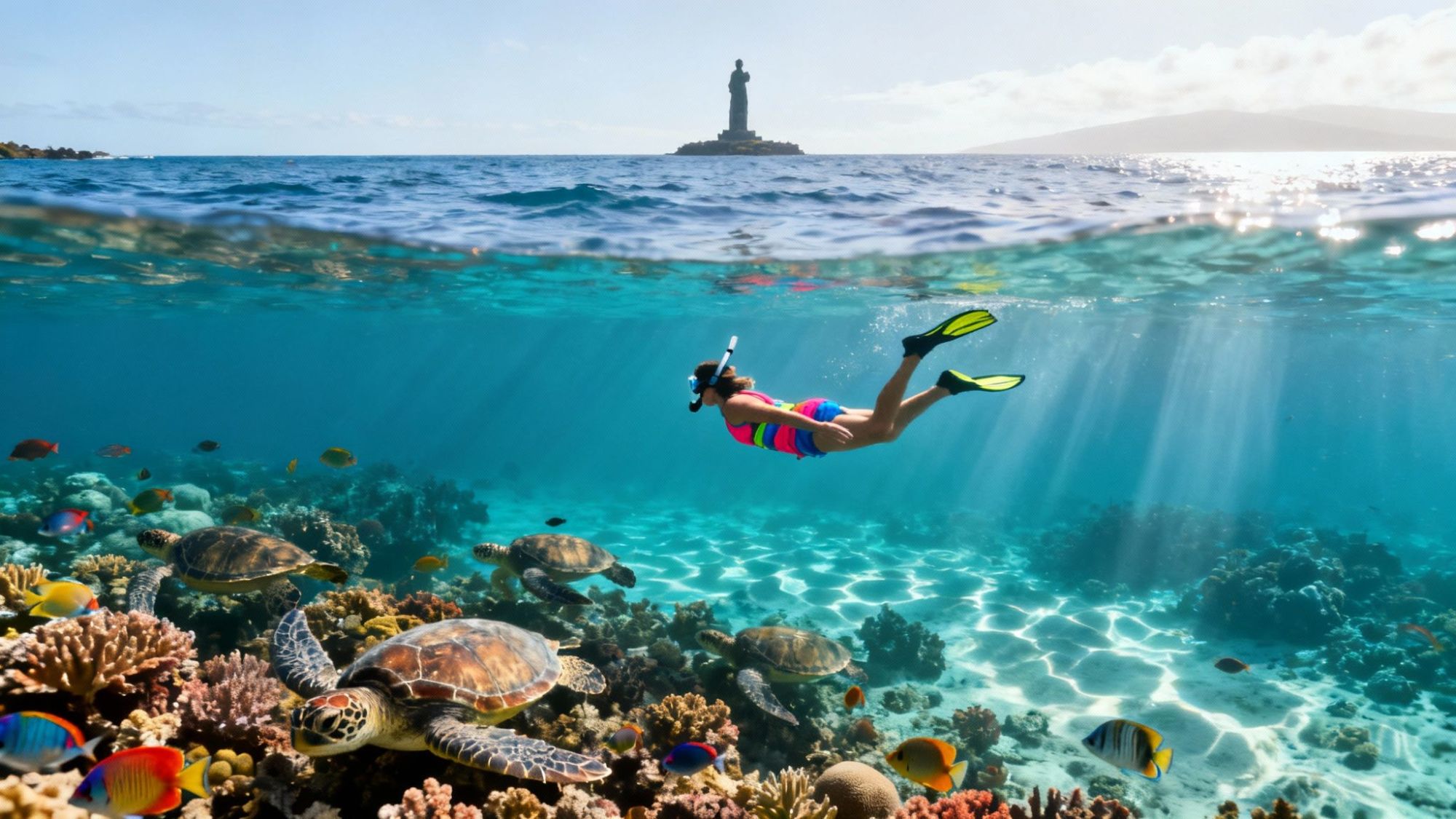
A Captain Cook snorkel tour is one of those iconic Big Island adventures. It takes you straight into the heart of Kealakekua Bay, a stunning and protected Marine Life Conservation District. This place is famous for its almost unbelievable water clarity, vibrant coral reefs, and a deep sense of Hawaiian history. It's hands-down one of the best snorkeling experiences you can have in all of Hawaii.
Your Essential Guide to a Captain Cook Snorkel Tour
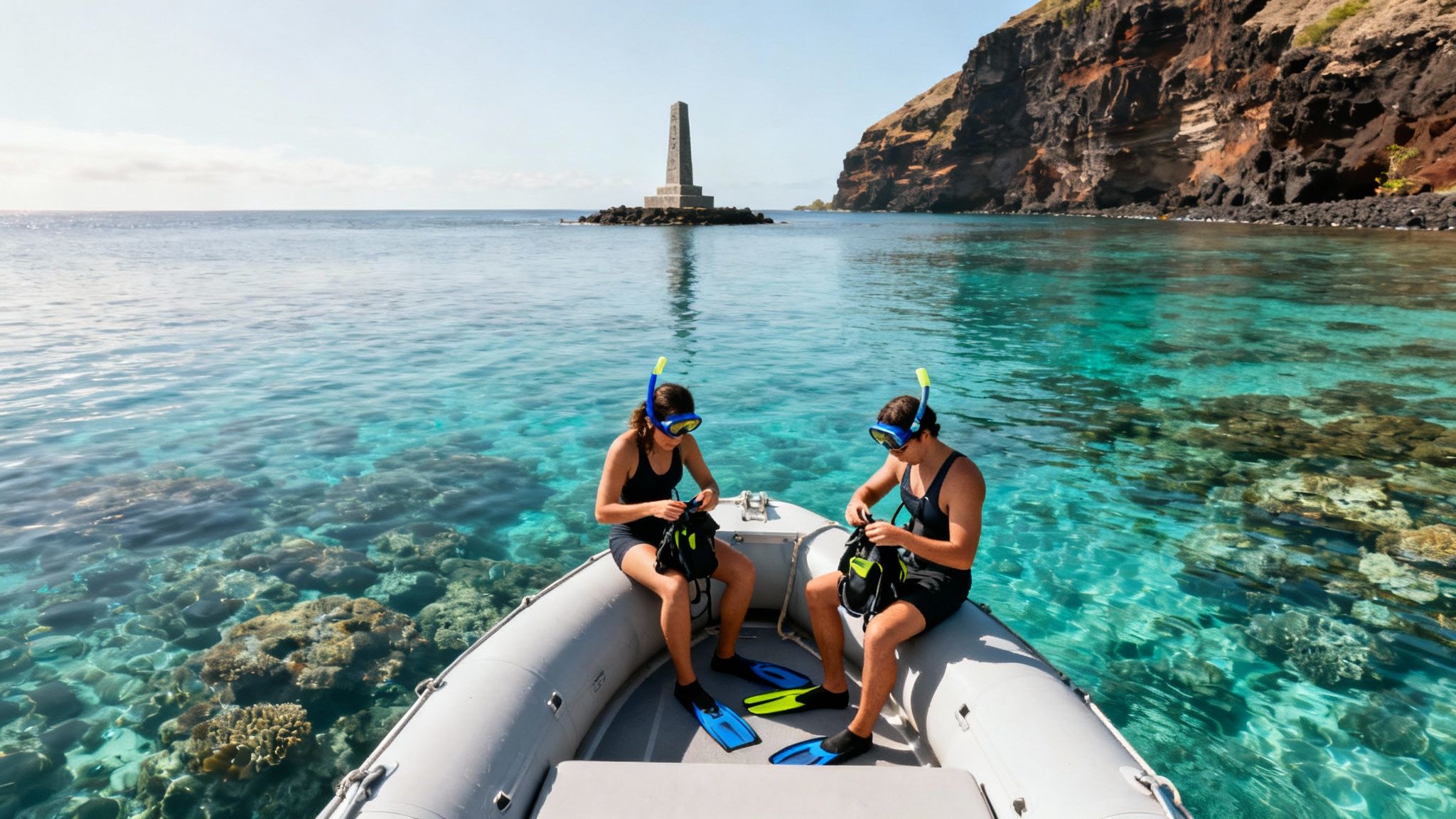
Picture this: you're gliding through calm, turquoise water so clear you feel like you can see forever. On a good day, visibility can easily exceed 100 feet straight down to the ocean floor. A Captain Cook snorkel tour isn't just a casual swim; it’s a full-on journey into a thriving underwater world.
What really makes this tour special is how it weaves together incredible natural beauty with a powerful dose of history. It all revolves around that famous white obelisk marking the spot where British explorer Captain James Cook died back in 1779.
This unique combination is what puts Kealakekua Bay on the map. Because the bay is a protected marine sanctuary, the coral gardens stay healthy and the fish are plentiful. The geography of the bay also acts as a natural shield from rough ocean swells, creating consistently calm conditions that are perfect for snorkelers of any skill level.
To give you a better idea of what to expect, here's a quick rundown of the tour's key details.
Captain Cook Snorkel Tour At a Glance
| Aspect | Details |
|---|---|
| Location | Kealakekua Bay, Big Island, Hawaii |
| Duration | Typically 3-5 hours, depending on the tour operator |
| Water Clarity | Up to 100+ feet of visibility |
| Key Highlights | Vibrant coral reefs, abundant tropical fish, potential spinner dolphin and sea turtle sightings |
| Historical Significance | Snorkeling near the Captain Cook Monument, marking a pivotal site in Hawaiian history |
| Best For | Snorkelers of all experience levels, from beginners to seasoned pros |
This table should give you a solid snapshot, but the experience itself is so much more than just a list of features.
What Makes This Tour a Must-Do Experience
Most of these trips last anywhere from three to five hours, depending on who you book with. You'll typically leave from somewhere along the Kona coast and enjoy a scenic boat ride down to the bay. Keep your eyes peeled—it's super common to see playful spinner dolphins showing off in the boat's wake.
But once you anchor in the bay, the real show begins.
Here’s a taste of what makes it so memorable:
- Insanely Good Snorkeling: The bay’s protected status means you’ll be swimming in calm, clear water surrounded by huge schools of yellow tang, colorful parrotfish, and maybe even a few Hawaiian green sea turtles (honu) cruising by.
- A Floating History Lesson: The guides are usually fantastic storytellers. They'll share tales about Captain Cook's arrival, his interactions with the Hawaiian people, and the cultural importance of Kealakekua Bay, which adds a whole other layer to the experience.
- Views You Can't Get From Shore: The boat ride itself is gorgeous. You get these sweeping, dramatic views of the rugged volcanic coastline that are impossible to appreciate from land.
The real magic of a Captain Cook snorkel tour lies in its ability to connect you with Hawaii's living history and its fragile marine ecosystem simultaneously. It’s more than an activity; it’s an immersive cultural and natural encounter.
At the end of the day, you're not just looking at a pretty reef; you're floating through a hugely significant piece of Hawaiian history. This mix of adventure, education, and pure natural wonder is exactly what elevates the Captain Cook snorkel tour from just another outing to a can't-miss Big Island experience.
The Rich History of Kealakekua Bay
When you join a Captain Cook snorkel tour, you're doing more than just exploring an underwater paradise. You're diving headfirst into a pivotal moment in Hawaiian history. The calm, turquoise waters of Kealakekua Bay hold stories that have echoed through the islands for centuries, giving your snorkel adventure a much deeper meaning. Think of it less as just a snorkeling spot and more as a living museum.
The bay's historical importance really boils down to the arrival of one person: British explorer Captain James Cook. What happened when he landed at Kealakekua Bay in 1779 is a central part of the story you'll hear on the tour. His arrival was the first major contact between Westerners and Native Hawaiians, and it happened during Makahiki—a sacred, peaceful festival honoring the god Lono. The timing of this was a huge deal, and you can get the full scoop on why it was so significant by learning more about the Captain Cook Monument's location and story.
At first, Cook and his men were welcomed, perhaps even seen as divine beings connected to the prophecies of Lono. But it didn't take long for cultural misunderstandings and simmering tensions to boil over into outright conflict.
The Monument and Cook's Final Days
This historic encounter came to a tragic end with Captain Cook's death right on the shore of the bay on February 14, 1779. Today, a stark white obelisk stands at the water's edge, marking the very spot where it all went down.
This image shows you the Captain Cook Monument at Kaʻawaloa, which is exactly where your snorkel tour will drop anchor.
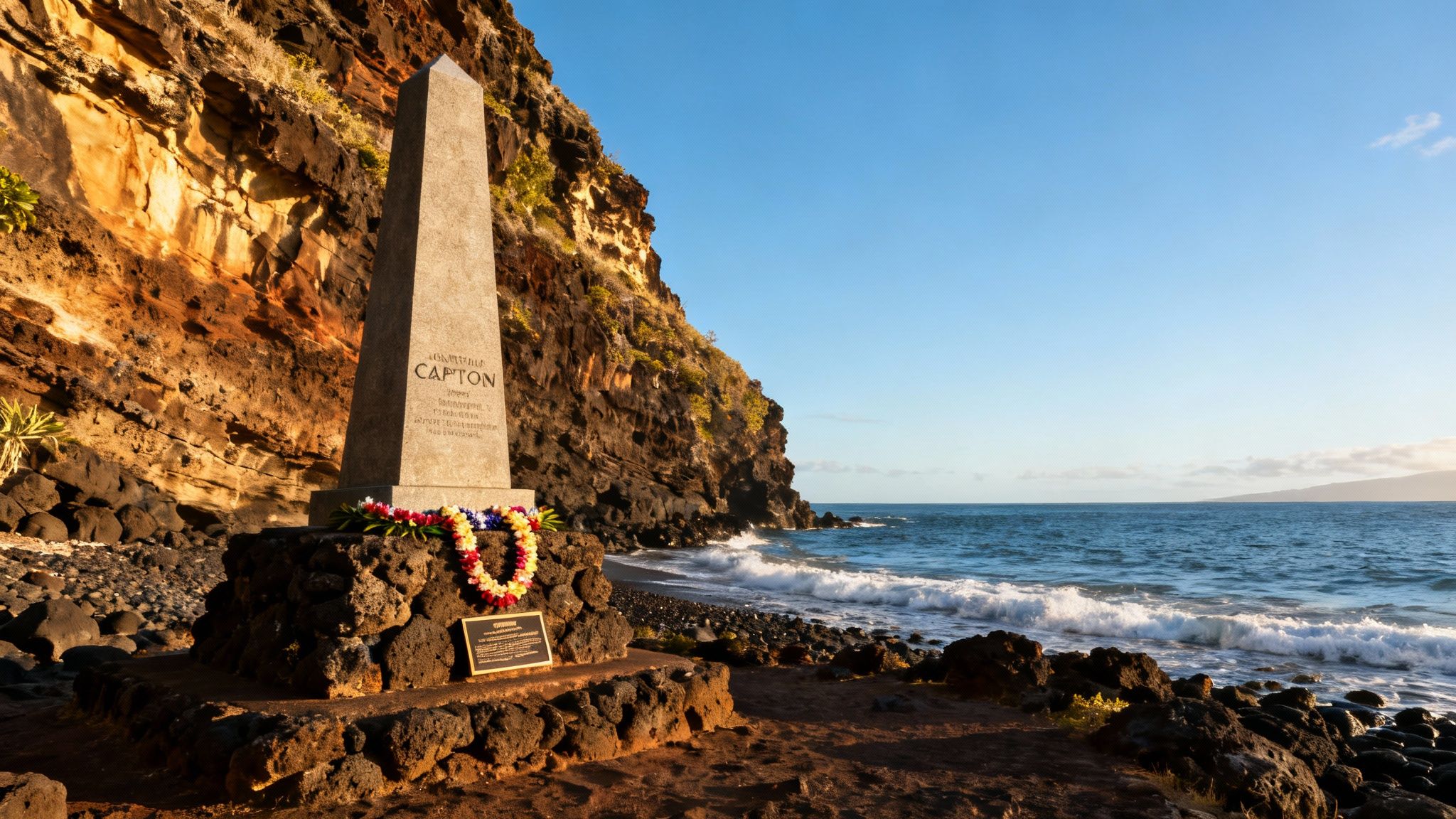
This monument isn't just a photo op; it's the centerpiece of the historical tale your guides will share. Understanding the story behind it connects the vibrant reef teeming with life below you to the powerful history that unfolded just a few feet away on the shoreline.
As you snorkel, you are literally floating over a site of immense cultural importance. Every colorful fish and piece of coral exists against the backdrop of one of Hawaii's most defining historical events.
This unique blend of stunning marine life and a dramatic past is what makes the whole experience so unforgettable. It turns a simple swim into a powerful lesson in Hawaiian heritage.
A Journey Through the Day's Itinerary
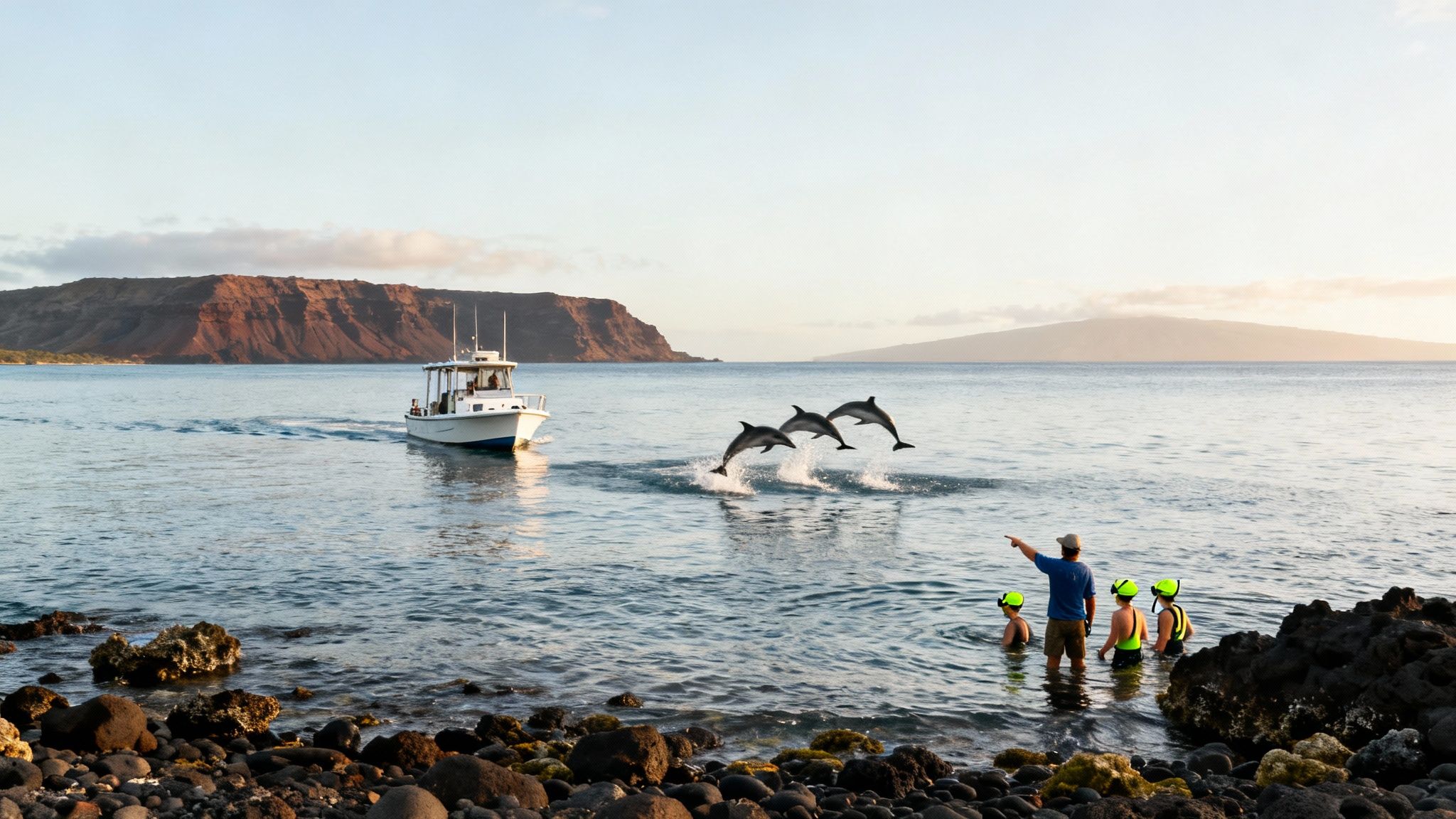
So what's the day actually like on a Captain Cook snorkel tour? Think of it as a half-day adventure that perfectly blends scenic cruising, wildlife spotting, and a bit of Hawaiian history. It’s definitely not just a boat ride out to a reef—it's a whole experience.
Things usually kick off with a morning check-in at one of the harbors along the Kona coast. The early start isn't just to get you out of bed; morning is when the seas are calmest and the skies are clearest, setting you up for a perfect day on the water. After getting checked in and hopping aboard, you’ll get a quick safety briefing from the crew before cruising down the coast.
This boat ride is really the first part of the adventure. As you head south toward Kealakekua Bay, you'll see the rugged, volcanic coastline in a way you just can't from shore. It’s also prime time for spotting some incredible marine life.
The Scenic Cruise and Dolphin Encounters
One of the biggest thrills on the way to the bay is the high chance of running into a pod of Hawaiian spinner dolphins. They're famous for their acrobatics, often leaping and spinning right next to the boat.
The guides have a knack for spotting them, and seeing these guys in their natural habitat is pretty magical. It’s a completely wild, unscripted moment that really sets the tone for the day before you even dip a toe in the water.
Of course, Kealakekua Bay is the main event. This place is a world-class snorkel spot, drawing over 190,000 visitors a year, and for good reason. It’s a protected Marine Life Conservation District, meaning the water is incredibly clear—often with visibility over 100 feet—and the fish are thriving. You can learn more about why the bay is so special at Kona Honu Divers.
Snorkeling at the Monument
Once you arrive, the boat anchors near the iconic white obelisk of the Captain Cook Monument. This is where the real fun begins. The crew will get you set up with all the gear you need—mask, snorkel, and fins—and give you a few pointers, whether you're a first-timer or an old pro.
Slipping into that warm, clear water feels like entering another world. Here's a taste of what you'll see:
- Vibrant Coral Gardens: The reef is a kaleidoscope of color, with healthy coral formations that are home to tons of fish.
- Abundant Marine Life: You’ll be swimming with huge schools of bright yellow tang, parrotfish, and dozens of other reef species.
- Honu Sightings: Keep an eye out for Hawaiian green sea turtles, or honu, as they glide gracefully through the water.
It's like swimming in a perfectly kept aquarium, except it’s all real. The sheer number of fish just below the surface is incredible and keeps you totally captivated the entire time you're in the water.
While you're snorkeling, the guides often share stories about Captain Cook’s fateful arrival and the bay's deep cultural significance. It adds another layer to the experience, connecting what you're seeing to the history that happened right there. After plenty of time exploring, you'll climb back on board for some snacks and drinks for a relaxing cruise back to the harbor, your head full of amazing underwater memories.
How to Choose the Right Snorkel Tour Operator
Picking the right Captain Cook snorkel tour can feel a bit overwhelming at first. You’ve got options ranging from small, zippy zodiacs to massive, comfortable catamarans. Understanding what makes each one different is the key to choosing the adventure that’s a perfect fit for you and your group.
Think of it like choosing a restaurant for dinner. Sometimes you're in the mood for a quiet, intimate cafe with super personalized service. Other times, you need a big, lively spot that can handle a family celebration with all the trimmings. Each has its own vibe, and the same goes for snorkel tours.
The tour operators in Kealakekua Bay each have their own specialty. Smaller boats tend to offer a more personal, adventurous feel, while the bigger vessels are all about comfort and family-friendly perks.
Comparing Large and Small Tour Boats
The boat you choose really sets the tone for your whole day. Smaller vessels, like the rigid-hulled inflatable rafts (often called zodiacs), create a much more up-close-and-personal journey. With fewer people on board, you get way more one-on-one time with your guides and a real sense of camaraderie with the other snorkelers.
On the flip side, large catamarans are built for pure comfort. They’re much more stable in the water, which is a huge plus if anyone in your group is prone to getting seasick. They also usually come loaded with amenities that can make the day feel more like a relaxing cruise, especially if you're traveling with kids.
For example, take a look at how Kona Honu Divers presents their tours on their website.
They really lean into the small group size, promising a more personal and less crowded snorkel. That’s a huge draw for people who want a quality experience and a closer connection with the incredible marine life.
Understanding the Trade-Offs
So, what's most important to you? Is it personalized attention, all-out comfort, or sticking to a budget? To help you decide, let's break down a real-world comparison.
Tour operators in Kealakekua Bay really run the gamut. A company like Kona Honu Divers focuses on small groups of 6–12 people for a 4-hour trip, typically costing $120–$180. Then you have Fair Wind Cruises, which can take 20–40 guests out for 5 hours at $150–$220, but they throw in extras like a full lunch buffet and even a water slide. You can explore more specifics about these tour options and their pricing.
This brings us to the core trade-off:
- Small Boats: Usually a bit cheaper with a shorter trip time, but you get that prized personal attention. Awesome for couples or serious snorkelers who just want to get in the water.
- Large Boats: Pricier and longer, but they come with more amenities like food and fun extras. The perfect choice for families or big groups who value comfort.
To make this even clearer, here's a quick look at some of the top operators side-by-side.
Comparison of Top Snorkel Tour Operators
This table gives you a snapshot of what to expect from some of the main players running tours to Kealakekua Bay. It's a great way to quickly see how they stack up on the things that matter most: group size, trip length, price, and what's included.
| Operator | Group Size | Duration | Price Range | Amenities |
|---|---|---|---|---|
| Kona Honu Divers | Small (6-12) | 4 Hours | $120 – $180 | Snacks, drinks, expert guides |
| Sea Quest Hawaii | Small (14-16) | 4-5 Hours | $140 – $190 | Snacks, drinks, sea cave exploration |
| Fair Wind Cruises | Large (20-40) | 5 Hours | $150 – $220 | Lunch buffet, water slide, bar |
| Captain Zodiac | Small (16) | 4 Hours | $130 – $170 | Snacks, drinks, adventurous ride |
Ultimately, there's no single "best" operator—it's all about finding the one that aligns with your vision for the perfect day. By weighing these factors, you can confidently book a Captain Cook snorkel tour that will give you amazing memories of this historic and beautiful bay.
Snorkeling Safely and Respectfully
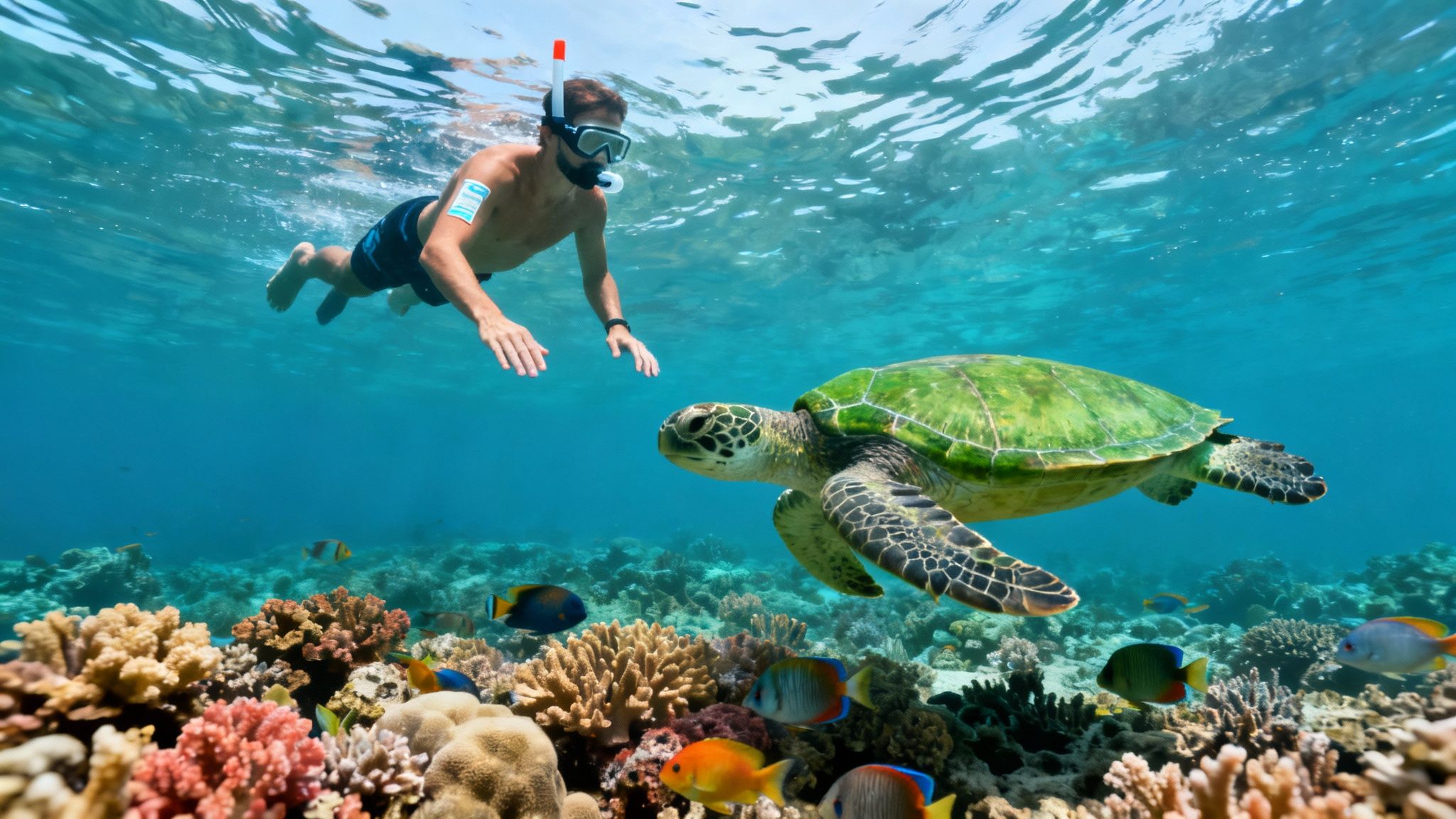
It's easy to get lost in the beauty of Kealakekua Bay, but it’s important to remember this isn't just another pretty spot—it's a protected Marine Life Conservation District. You can think of it as an underwater national park where every fish, coral head, and creature is a protected resident. Being a responsible visitor is the only way we can keep this paradise thriving for years to come.
Your Captain Cook snorkel tour is an incredible chance to see this delicate ecosystem firsthand. But with that privilege comes a big responsibility. Everything you do, from the type of sunscreen you put on to how you kick your fins, has a real impact on the health of the reef.
Protecting the Reef and Its Inhabitants
One of the single most important things you can do is give the coral its space. It might look like rock, but coral is a living animal. The slightest touch from a hand or a fin can break off decades of growth or leave it vulnerable to disease. It’s a fragile world down there.
To help keep this amazing place healthy, just follow a few simple guidelines:
- Go Reef-Safe with Your Sunscreen: Many common sunscreens contain chemicals like oxybenzone and octinoxate, which are incredibly harmful to coral. Always opt for a mineral-based, reef-safe formula to protect both your skin and the ocean.
- Look, But Please Don't Touch: Keep a respectful distance from all marine life you encounter, whether it's sea turtles (honu), dolphins, or colorful fish. Chasing or touching animals causes them stress and can disrupt their natural behaviors.
- Watch Your Fins: Get comfortable floating horizontally and use slow, gentle kicks. Standing on or accidentally kicking the coral can destroy it in an instant.
Preserving Kealakekua Bay is more than just a list of rules; it's about having a mindset of pure respect. The moment you slip into the water, you're a guest in the home of thousands of creatures. If you act like a good guest, their home will stay healthy and safe for everyone to enjoy.
Onboard and In-Water Safety
Your tour crew will give you a solid safety briefing before you get in the water, and it pays to listen up. Know where the life vests are, follow your guide's instructions, and never, ever be shy about asking a question if you're feeling unsure about something.
If you want to feel extra confident before the trip, check out our guide on https://konasnorkeltrips.com/blog/snorkeling-safety-tips/. A little preparation goes a long way. Ultimately, your personal safety and the health of the reef are tied together, and focusing on both is what makes for a truly unforgettable adventure.
Packing and Preparing for Your Snorkel Adventure
A little bit of prep work can be the difference between a great Captain Cook snorkel tour and a truly unforgettable one. Thinking through what to pack ahead of time means you'll be comfortable, protected from the island sun, and free to focus on the jaw-dropping underwater world of Kealakekua Bay.
Your tour operator provides the big stuff—mask, snorkel, and fins—but a few personal items will seriously upgrade your day. Just think of it like packing a beach bag, but with a few smart additions for a day out on the boat.
Your Essential Packing Checklist
Having these basics covered means you won’t be worrying about anything but the incredible views. For a deeper dive into what to wear, you can check out our detailed guide on what to wear for snorkeling.
Here’s a simple checklist to get you rolling:
- Reef-Safe Sunscreen: This is a must. Standard sunscreens are loaded with chemicals that are incredibly damaging to our fragile coral reefs. Grab a mineral-based one to protect your skin and the marine life.
- Swimsuit and Cover-Up: The easiest way is to wear your swimsuit under your clothes so you're ready to jump in. A light cover-up or rash guard is also a lifesaver for sun protection, both on the boat and in the water.
- Towel and Dry Bag: A quick-drying towel is your best friend. A dry bag is just as critical for keeping your phone, wallet, and other essentials safe and splash-free.
Packing for a snorkel tour is all about comfort and protection. Simple things, like a good hat and the right sunglasses, can make a huge difference in how much you enjoy your day on the water.
Small Items That Make a Big Impact
Beyond the essentials, a couple of extras can really elevate your experience. To cut the glare off the water's surface—a huge help on the boat ride and when you're peering into the bay—think about bringing a good pair of polarized eyewear. The difference is night and day.
Also, if you're someone who gets a little queasy on boats, it's a good idea to bring an over-the-counter remedy just in case. And of course, don't forget a waterproof camera or a phone in a waterproof case! You'll want to capture those amazing moments with the colorful fish and coral. With these things in your bag, you're all set for an incredible adventure.
Got questions about the Captain Cook snorkel tour? You're not alone. Here are some quick answers to the most common things people ask, covering everything from the best seasons and what to do if you're not a pro swimmer, to weather policies and how to book.
Think of this as your cheat sheet for planning a perfect, worry-free day in Kealakekua Bay.
When Is The Best Time To Visit?
For the absolute clearest water, aim for sometime between April and October. That's our dry season, so there’s much less rain, and the visibility underwater can easily top 100 feet. It makes spotting all the colorful fish and coral a truly incredible experience.
If you're looking to dodge the crowds, the shoulder seasons in spring and fall are fantastic. You still get those calm, beautiful seas but with fewer people around. On the other hand, visiting in the winter gives you a shot at spotting humpback whales during the boat ride, which is a pretty epic bonus.
Even paradise gets the occasional storm, but tour operators are always watching the forecasts and will adjust schedules for safety.
- Morning tours usually mean calmer water and softer light for photos.
- Give yourself at least 3-5 hours for the whole adventure, including the boat ride.
- It never hurts to check with your guides about the day's sea conditions before you head out.
What If I'm Not A Strong Swimmer?
No problem at all. Every tour starts with a safety briefing where you'll get a flotation vest and a quick lesson on using your mask and snorkel. The guides are always in the water with you and are pros at helping swimmers of every skill level feel comfortable.
"Every guest is supported from the moment they step on deck to their last fin kick." — Local guide insight
If you're really not feeling up for a swim, some tours offer a glass-bottom boat option. You can also just hang out on the deck, soak up the sun, and listen to the guides share cool facts about the marine life below.
How To Handle Weather Cancellations
Safety always comes first. If the winds are too high or the seas get too rough, tours will be canceled. When this happens, operators are great about offering a full refund or helping you reschedule for another day.
- Get in touch with your tour operator by phone or email within 24 hours of the cancellation notice.
- Let them know if you want to pick a new date or get a 100% refund.
- Make sure to confirm any changes at least 48 hours before your new tour time.
It's always a good idea to peek at the weather forecast before your trip and have travel insurance that covers this kind of stuff, just in case.
Most tour companies link their booking systems to live weather forecasts, so you'll usually get an alert well ahead of time if things are looking dicey.
Booking your spot is super easy over at the Kona Snorkel Trips website. Just pick your date, tell them how many people are in your group, choose a departure time, and you can pay securely right then and there.
You'll get an email confirmation right away with all the details, like where to pick up your gear and a reminder a couple of days before you go.
If you need any special arrangements, like specific equipment or extra help from a guide, just reach out to their customer support at least 72 hours ahead of time.
A few final tips for a smooth day:
- Show up about 15 minutes early to get checked in and fitted for your gear without any rush.
- Don't forget reef-safe sunscreen and a reusable water bottle.
- Wear your swimsuit under your clothes so you can hop in the water as soon as you get there!
Ready to see it for yourself? You can book your Captain Cook snorkel tour right now with Kona Snorkel Trips at https://konasnorkeltrips.com.
